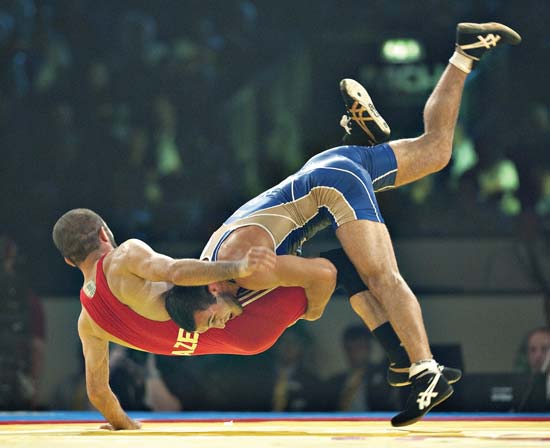- November 12, 2024
- Comments (0)
Wrestling is one of the oldest and most universally practiced sports, with a history that dates back thousands of years. This physically demanding combat sport involves grappling techniques like throws, takedowns, pins, joint locks, and holds. Wrestlers aim to outmaneuver their opponents and achieve control to win matches, whether in amateur competitions, professional leagues, or theatrical performances. The sport requires a unique blend of strength, strategy, agility, and endurance, making it both physically and mentally challenging.
The Origins of Wrestling
Wrestling’s origins stretch back to ancient civilizations. Evidence of wrestling matches can be found in cave drawings in France dating to 15,000 years ago, as well as in ancient Egyptian tombs. The sport was a significant part of early Greek and Roman cultures, eventually becoming a central event in the ancient Olympic Games. Wrestling has been adapted and transformed by various cultures around the world, evolving into a variety of forms and styles that reflect each region’s traditions and values.
Types of Wrestling
Wrestling today can be categorized into several styles, each with its own techniques, rules, and objectives. Here are some of the most popular types:
- Freestyle Wrestling: In this style, wrestlers are allowed to use their legs in both offense and defense, making it highly dynamic. Freestyle wrestling is an Olympic sport and is one of the most widely practiced wrestling styles globally.
- Greco-Roman Wrestling: Another Olympic discipline, Greco-Roman wrestling forbids holds below the waist. This style emphasizes upper body strength and throws, making it distinct and challenging.
- Collegiate Wrestling (Folkstyle): Also known as “folkstyle,” this is the predominant wrestling style in American high schools and colleges. The scoring system and rules focus on control, escapes, and pinning the opponent.
- Professional Wrestling: While it includes grappling techniques, professional wrestling (like WWE) is primarily a form of entertainment. Matches are pre-scripted, with elaborate storylines and characters. This type of wrestling, however, requires high-level athleticism and performance skills.
- Sumo Wrestling: Originating in Japan, sumo wrestling involves large, powerful wrestlers trying to force each other out of a ring or onto the ground. It’s steeped in tradition and ritual, making it more than just a sport in Japanese culture.
- Traditional and Folk Wrestling Styles: Around the world, many countries have developed their own forms of wrestling. For example, Luta Livre in Brazil, Pehlwani in India and Pakistan, and Mongolian wrestling are just a few examples of wrestling styles specific to particular cultures.
The Rules and Objectives of Wrestling
The basic objective of wrestling is to defeat your opponent by either pinning them (holding both their shoulders on the mat) or accumulating points through various techniques and holds. Wrestlers score points for moves such as takedowns, escapes, reversals, and near-falls. Each match typically has a time limit, and the wrestler with the highest score at the end of the match, if there’s no pin, is declared the winner.
Key Skills and Physical Demands
Wrestling is physically intense and requires a unique combination of strength, endurance, balance, and agility. Wrestlers must be able to execute powerful movements while maintaining their stance and controlling their balance. A high level of mental toughness is essential, as wrestling is not only physically demanding but also requires strategic thinking and quick reactions to the opponent’s moves.
Training for wrestling typically includes strength conditioning, cardiovascular fitness, agility drills, and skill-specific techniques. Wrestlers also focus on developing flexibility and mobility, which are essential for executing moves effectively and avoiding injuries.
Wrestling as a Spectacle and Entertainment
In addition to amateur and Olympic wrestling, professional wrestling has become a major form of entertainment worldwide. Organizations like WWE, AEW, and NJPW create dramatic storylines and complex characters, attracting fans with a mix of athleticism and theatrics. Although the outcomes are predetermined, the athletic ability and physical demands on performers are real. Professional wrestling has carved out its own unique niche, blending sport with showmanship.
The Cultural Impact of Wrestling
Wrestling holds a deep cultural significance in many societies. From ancient traditions to modern competitions, it represents more than just physical prowess; it’s often a test of personal strength, discipline, and honor. Wrestling has inspired countless athletes and fans, teaching values of resilience, respect, and perseverance.
In communities around the world, wrestling serves as a vehicle for social bonding, national pride, and individual empowerment. Wrestling clubs, teams, and leagues provide support networks for athletes, helping them build confidence and camaraderie.
Wrestling Today and Its Global Popularity
Wrestling remains popular around the world, and its international appeal has only grown over time. Wrestling’s place in the Olympics showcases the sport on a global stage, while professional wrestling promotions continue to attract millions of fans with televised events, merchandise, and live shows. From youth wrestling programs to high school and collegiate tournaments, wrestling continues to be a rite of passage for young athletes, teaching discipline and hard work.
Conclusion
Wrestling is a unique blend of athleticism, skill, and tradition. Whether it’s practiced as a competitive sport, a form of entertainment, or a cultural ritual, wrestling has left a lasting impact across history and around the globe. For many, wrestling is more than a sport; it’s a way to build character, test physical limits, and honor ancient traditions in a modern world.


